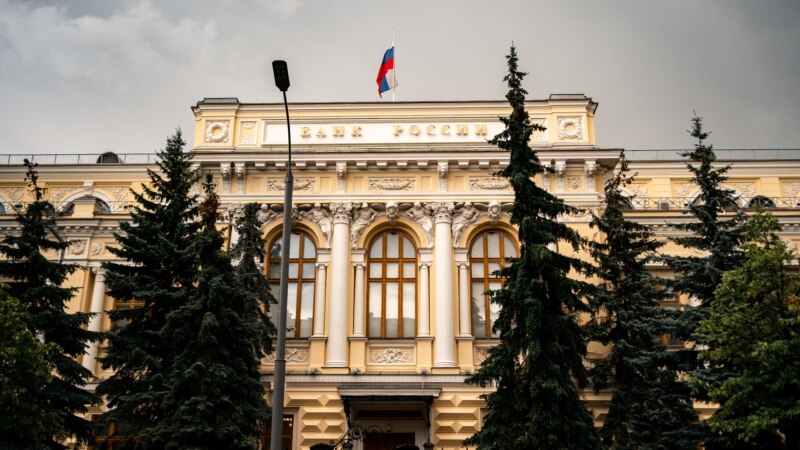
As the U.S. Congress fights over an aid package that could deliver an additional $60 billion in emergency assistance to Ukraine, some lawmakers in the United States and other large, allied democracies have their eyes on a much larger pot of potential funding: Russian central bank assets frozen in Western financial institutions.
In recent weeks, there has been growing momentum behind efforts to permanently seize the frozen funds, estimated to total approximately $300 billion, and use them to help Ukraine offset the vast cost of rebuilding its towns and infrastructure destroyed by Russia’s invasion.
In Washington, the Biden administration has signaled its support for a legislative effort to smooth a path toward seizure of the approximately $50 billion-$60 billion in Russian funds held by U.S. financial institutions.
Europe, where most of the Russian funds currently reside, appears to be taking a more cautious path that could lead to the interest earned by frozen Russian funds being directed to Ukraine’s use, while leaving the underlying funds untouched.
The G7 group of large economies has backed a suggestion that the frozen Russian assets be treated as collateral for zero-interest loans that could be used to fund Ukrainian reconstruction.
Sending a message
Supporters of confiscating Russian funds say that doing so is necessary to underscore the community of nations’ disapproval of Russia’s actions.
“I think it sends a signal that egregious aggression of this form will not be tolerated,” Simon Johnson, an economist at Massachusetts Institute of Technology, told VOA.
Johnson said it is unprecedented for a country that starts a war of aggression like the one Russia is waging in Ukraine to have such large foreign reserves.
“They built up these reserves, I think, thinking they would give them a buffer that would allow them to behave in a more reckless manner,” Johnson said. “And I think the message should be sent to them and others that actually, if you want to engage with the world economy and with the U.S. and with others, that’s not how it’s going to work. You’re not going to be able to run these current account surpluses, and then use that to finance your wars.”
Russian retaliation
Russian officials have threatened to retaliate for any seizure of the country’s assets with similar seizures of Western assets under Russian jurisdiction, though it is unclear whether a comparable amount of foreign assets is held in Russian banks.
“Of course, the Russian Federation will challenge such decisions. We will protect our interests and our assets illegally seized,” Kremlin spokesperson Dmitry Peskov told Reuters earlier this month. “Encroachment on someone else’s property undermines all the foundations of the economic system, including the economic system of those who will implement these decisions.”
He added, “We are convinced that decision-makers also understand the inevitability of these consequences. We are watching very closely.”
International law
But supporters of the move say the options being considered to seize Russian assets are all compatible with existing international law.
“The general view by many lawyers from multiple countries is that if this decision is made by international bodies, that it is an ‘authorized taking,’ whether it be the pledge against loans or just expropriating the assets themselves,” Mark Kennedy, director of the Wilson Center’s Wahba Institute for Strategic Competition, told VOA.
“I think it is going to happen in some way, shape or form, though whether it’s near term or not is yet to be seen,” he said. “There’s a feeling that this is appropriate justice, vis-a-vis Russia.”
‘REPO’ Act
There is currently some disagreement in the U.S. about whether the government has the legal authority to go beyond simply freezing Russian funds and actually transfer the ownership of them to a third party.
Harvard University law professor Laurence H. Tribe and several colleagues last year produced a lengthy report asserting that current U.S. law offers the government sufficient authority to transfer Russian assets held in the U.S. to Ukraine.
However, not everyone agrees.
“The executive branch and Treasury … have the power to freeze, and they have the power to transfer possession of assets so that they are safe from grab-backs by their owners,” Paul B. Stephan, a professor of law at the University of Virginia, told VOA. “But the word ‘transfer’ in the statute clearly applies only to possession and not ownership.”
In Washington, both the House and the Senate are considering a piece of legislation — the Rebuilding Economic Prosperity and Opportunity (REPO) for Ukrainians Act — that would explicitly authorize the president to confiscate Russian assets held in financial institutions under U.S. jurisdiction.
The funds would be deposited in an account, the Ukraine Support Fund, which would be created by the legislation.
Stephan, who said he personally supports the idea of using Russian assets to aid Ukraine, said the REPO Act would remove any legal barrier to seizing ownership of Russia funds. However, he described other aspects of it, such as language that bars U.S. courts from hearing claims against such asset seizures, as “problematic.”
EU and G7
In Europe this week, the European Union passed legislation requiring financial institutions that hold more than $1.2 million in Russian central bank assets to place revenue earned by those assets in separate accounts.
The idea is that future legislation will be considered to create a mechanism by which the European Commission can transfer those profits to the EU budget, and then on to Ukrainian control.
Separately, the G7 countries have been considering a somewhat different plan. Because the international community generally recognizes that Russia will be liable to pay Ukraine reparations at the end of the conflict, the world’s largest economies are considering measures that would treat frozen Russian funds as collateral against loans taken out to assist Ukraine in rebuilding.
The plan would involve the creation of a special purpose vehicle to issue so-called “zero-coupon” bonds, which require no interest payments, backed by the frozen funds.
